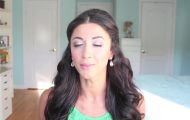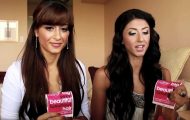If there are five items on the table, count them separately, then group them together so that they still make five. Ask her to take away two things and show her that three are left. She has done her first sum!
Never make it a test. It is a game, it is fun and it should never become stressful for the child. Work out your own variations. Count the buttons on her jersey or the steps in the house. You can add other dimensions by counting all the red flowers on a place mat; or the yellow squares on a cereal box. Dont boggle her mind with too much. She needs a lot of repetition and comprehension before you move on to the more complex thoughts.
By the time she is three she should be able to use abstract thought, that is to picture things in her mind without seeing them. Ask her how many dolls she has got when she is not in the room with them. If she says two and it is right, go on to describe them: Yes, thats right, two dolls – one with brown hair and one with blonde hair Susie has the dark hair and Jenny the light hair.Amplification like this enriches her vocabulary and adds to her store of information.
Basic maths. Number concepts, outlined above, are needed for mathematics. Shapes, classification and mass are also important. The identification of shapes circles, squares, triangles and rectangles – are all that is needed when a child starts school.
Circles are the easiest for children to draw. Draw a circle then ask her to copy it. Draw two circles, one above the other, and ask her to copy them. Then draw three circles and ask her to copy them. It is difficult for a three year old to get the placing right when you have drawn more than one circle. But if she can draw a recognisable figure by the time she is three or four, even if it is a stick figure, as long as the head, body and legs are in the right place, the chances are that she will not have difficulty in learning to read or write.
Point out shapes in the same way as you pointed out numbers to her: a plate is circular, how many other circles can you see? Children are usually not very good at recognising shapes if they are very large, like a square table, but will pick out the squares on a cereal box or a tiled wall easily. Do not worry if your child
cannot do this at three. There is plenty of time. Take it slowly. Even five year olds dont know what a triangle looks like. You can cut out shapes from cardboard or felt – circles, triangles, rectangles, squares can be used to make figures, houses, hats or whatever her imagination runs to. You can mark out triangles, squares, circles and rectangles of various sizes on stiff cardboard. Then cut out the same shapes the same size from another piece of cardboard or felt and ask your child to put the shapes into the correct spaces. If you use bright colours she should enjoy doing it. But it is difficult so dont give her too many shapes to start with or she will not be able to do it and lose interest. Gradually build up the number of shapes she has to start with. This is an excellent exercise for spatial perception which is needed for maths, reading and writing.
Science. We deal with scientific concepts all the time – when we bake a cake, grow a plant, light a fire, or switch on a light. Get the meaning of words like big and small, short and tall clear in your childs mind. Look at that tall man -next to him you are very short… Draw a big man and a small man for mummy. Feel the empty plastic bottle – it is very light. Fill the bottle with water and it feels heavy. Fill another bottle the same size with sand – does it feel heavier or lighter? Point out that a small stone is heavier than a large ball of wool. Give her a chance to show you something that proves these principles. She may be five or even six before she can do it but she will still have been absorbing the principles. Bathtime provides a great opportunity for pointing out cause and effect. Let her test things to see what will float. .. the empty bottle with the lid on it will float, because it has air trapped inside it. . . the empty bottle without a lid fills with water and sinks. A stone sinks, a cork floats.
Maybe You Like Them Too
- 50 Unique Travel Destinations You Must Visit Before You Die
- Tamar Braxton A Life in Music
- Sunny Hostin A Biography
- Steve Coogan A Life in Comedy
- Sterling K Brown A Biography


